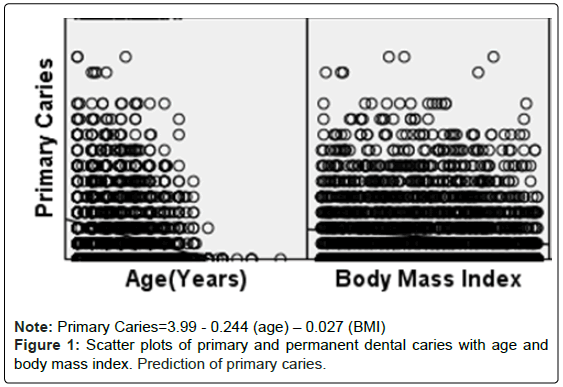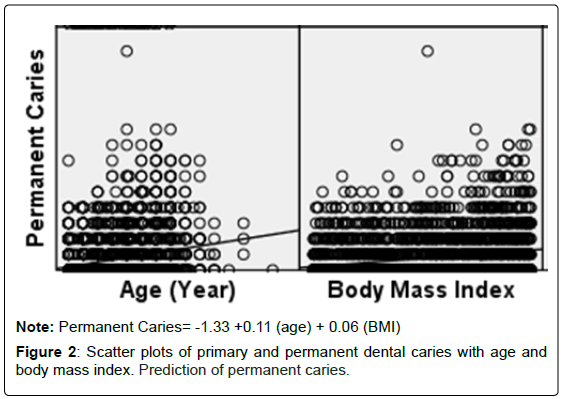Prediction of Primary and Permanent Dental Caries Using Age and Body Mass Index
Received: 13-Nov-2017 / Accepted Date: 30-Nov-2017 / Published Date: 14-Dec-2017 DOI: 10.4172/2332-0702.1000229
Abstract
Dental caries is a biofilm-mediated, sugar-driven, multifactorial, dynamic disease that results in the phasic demineralization and re-mineralization of dental hard tissues, population of several countries is suffering from this problem, children and adults both are found at risk with this disease. Literature gives the evidence that dental caries are associated with age, primary caries found more prevalent at early age group and permanent caries found more prevalent at older age group, whereas some of the studies did not give any significant association between dental caries and body mass index. This study was aimed to see the relationship of primary and permanent caries with age and body mass index, and developing a regression model for caries prediction, In the current study a part of a secondary baseline data for dental caries project of Pakistani children was used, STATA 12.0 MP was used to estimate multiple regression models for primary and permanent dental caries prediction using and age in years and body mass index as predictor variables. results showed, primary DMFT gives 27.2% negative correlation with age, permanent DMFT gives 23.8% positive correlation with age and 22.5% positive correlation with body mass index, This study concludes that increase in age and body mass index could less the chances of primary caries but increase the chances of permanent caries in the population.
Keywords: Dental caries; Primary; Age; Body mass index
Introduction
Dental caries is a biofilm-mediated, sugar-driven, multifactorial, dynamic disease that results in the phasic demineralization and remineralization of dental hard tissues [1] population of several countries is suffering from this problem, children and adults both are found at risk with this disease, a study was conducted in Saudi Arabia among school going children reports 68.9% children were getting effected with this problem [2], another study form Bangalore reports 65.7% prevalence among school going children aged 3-5 years old [3], one more study from India gives 36.5% prevalence of dental caries [4], in Pakistan it was found 51% [5].
Literature gives the evidence that dental caries are associated with age, primary caries found more prevalent at early age group and permanent caries found more prevalent at older age group [6], similarly dental caries are also associated with body mass index, there was significant association reported between dental caries and body mass index [7,8]. However some of the studies did not give any significant association between dental caries and body mass index [9,10].
Literature showed age and body mass index are not only indicator of dental caries, poor oral hygiene and bad eating habits can also give the effect on caries, a study from united states showed that young children with poor diets habits were more likely to have caries [11].
Objective
This study was aimed to see the relationship of primary and permanent caries with age and body mass index, and developing a regression model that can helped in prediction of primary and permanent dental caries using age and body mass index as predictors using multiple linear regression as tool.
Subjects and Methods
In the current study a part of a secondary baseline data for dental caries project of Pakistani children was used, funded by Higher Education Commission, Islamabad, titled ‘Time and Sequence of Eruption Teeth of Pakistani Children [12]. The co-author of this study is the Principal Investigator of that Project.
Sampling technique
We are using secondary data and at primary level in project [12]. Multistage Systematic Cluster Random sampling was performed to collect the data on study variables includes age and body mass index. The dentists were also examined the children for primary and permanent dental caries.
Study population
School going children aged between 5 – 19 years old form Larkana (Sind province) and Peshawar (KPK province) City of Pakistan.
Statistical analysis
STATA 12.0 MP was used to estimate multiple regression models for primary and permanent dental caries prediction using and age in years and body mass index as predictor variables, before developing of regression models person correlation was tested between response and independent variables of models further beta coefficient with standard error of regression model were reported with their test of significance, coefficient of determination was also used to get an idea on the explained variation in the dependent variable of the model. P-values less than 0.05 were considered significant. Scatter plot of primary and permanent dental caries with age and body mass index were also reported to observe the trend in data.
Results
Table 1 reports the person correlation matrix of primary and permanent decayed, filling, missing teeth with age and body mass index, results showed, primary DMFT gives 27.2% negative correlation with age, and 11.8% negative correlation with body mass index, whereas permanent DMFT gives 23.8% positive correlation with age and 22.5% positive correlation with body mass index, these all correlation were considered statistically significant with p-value less the 0.05.
| PRIMARY DMFT | Permanent DMFT | Age | BMI | |
|---|---|---|---|---|
| Primary DMFT | 1.000 | |||
| Permanent DMFT | -0.0153 | 1.0000 | ||
| 0.3753 | ||||
| Age | -0.2720* | 0.2380* | 1.0000 | |
| <0.01 | <0.01 | |||
| BMI | -0.1185* | 0.2257* | 0.3190* | 1.0000 |
| <0.01 | <0.01 | <0.01 |
* p<0.05 considered significant
Table 1: Person correlation matrix.
Table 2 reports the stata outputs of two multiple regression models. Figure 1 gives the prediction of primary decayed, filled, missing teeth using information on age and body mass index, it was found that, one year increase in age will give 0.24 unit decreased in primary dental caries on average, similarly one unit increased in body mass index will gives 0.027 unit decreased in primary dental caries, these findings were found statistically significant with p-value less the 0.001, the adjusted model r-square suggested that, 7.4% variation in primary dental caries was explained by the help of age and body mass index.
| Model-I | Model-II | |
|---|---|---|
| Primary DMFT | Permanent DMFT | |
| Age (year) | -0.244*** | 0.112*** |
| -0.0169 | -0.0109 | |
| BMI | -0.0273* | 0.0698*** |
| -0.0106 | -0.00685 | |
| Constant | 3.991*** | -1.399*** |
| -0.195 | -0.126 | |
| N | 3314 | 3314 |
| R-sq | 0.074 | 0.085 |
| adj. R-sq | 0.074 | 0.084 |
***Standard errors in parentheses
Table 2: Regression models for primary and permanent decayed, filled, missing teeth.
Figure 2 was used to estimate the permanent dental caries, results showed a one unit increase in age will gives 0.11 unit increased in permanent caries on average, and one unit increase in body mass index will gives 0.06 unit increase in permanent caries, these findings were found statistically significant with p-value less than 0.001. The adjusted model r-square shows, 8.4% variation in permanent caries was explained by the help of age and body mass index.
Discussion
Our study showed a significant negative correlation between primary dental caries with age and body mass index and positive correlation of permanent dental caries with age and body mass index, a study showed children aged between 5- 8 years old were higher risk of primary caries as compare to aged between 11-15, that evidence a negative correlation between age and primary caries, similarly a positive correlation between permanent caries with age and body mass index justified the findings on primary caries in symmetric. Correlation findings allow us to develop some regression model to estimate the primary and dental caries after getting information in age and body mass index, our regression model showed increased in body mass index gives negative impact on primary caries and positive impact on permanent caries, a study from Sri Lanka also gives the association of dental caries with underweight [13], another study form Karachi (Pakistan) also reported a slight significant association of obesity with dental caries. One more study was done on elementary school children of German city gives positive association of caries with elevated weight children [8]. The model coefficient of determination were 7.4% and 8.4% therefore the model for permanent dental caries could provide more efficient estimates for permanent caries after using information on age and body mass index, however both models ANOVA were found statistically significant that gives the evidence that our fitted model are considerable for the estimation of primary and dental caries.
Conclusion
This study concludes that primary caries significantly negatively associated with age and body mass index whereas permanent caries gives significant positive association with age and body mass index, there for increase in age and body mass index could less the chances of primary caries but increase the chances of permanent caries in the population.
References
- Pitts NB, Zero DT, Marsh PD, Ekstrand K, Weintraub JA, et al. (2017) Dental caries. Nat Rev Dis Primers 3: 17030.
- Amin TT, Al-Abad BM (2008) Oral hygiene practices, dental knowledge, dietary habits and their relation to caries among male primary school children in Al Hassa, Saudi Arabia. Int J Dent Hyg 6: 361-370.
- Vanishree N, Rosa R, Narayan, Naveen N, Anushri M, et al. (2017) Relationship of dental caries and BMI among pre-school children of Bangalore city, India: a cross sectional study. ‎Int J Community Med Public Health 4: 814-819.
- Plaka K, Ravindra K, Mor S, Gauba K (2017) Risk factors and prevalence of dental fluorosis and dental caries in school children of North India. Environ Monit Assess 189: 40.
- Dawani N, Nisar N, Khan N, Syed S, Tanweer N (2012) Prevalence and factors related to dental caries among pre-school children of Saddar town, Karachi, Pakistan: A cross-sectional study. BMC Oral Health 12: 59.
- Dash JK, Sahoo PK, Bhuyan SK, Sahoo SK (2002) Prevalence of dental caries and treatment needs among children of Cuttack (Orissa). J Indian Soc Pedo Prev Dent 20: 139-143.
- Bagramian RA, Garcia-Godoy F, Volpe AR (2009) The global increase in dental caries. A pending public health crisis. Am J Dent 22: 3-8.
- Willerhausen B, Blettner M, Kasaj A, Hohenfellner K (2007) Association between body mass index and dental health in 1,290 children of elementary schools in a German city. Clin Oral Investig 11: 195-200.
- Sadeghi M, Lynch CD, Arsalan A (2011) Is there a correlation between dental caries and body mass index-for-age among adolescents in Iran? Community Dent Health 28: 174.
- D'Mello G, Chia L, Hamilton SD, Thomson WM, Drummon BK (2011) Childhood obesity and dental caries among paediatric dental clinic attenders. Int J Paediatr Dent 21: 217-222.
- Dye BA, Shenkin JD, Ogden CL, Marshall TA, Levy SM, et al. (2004) The relationship between healthful eating practices and dental caries in children aged 2-5 years in the United States, 1988-1994. J Am Dent Assoc 135: 55-66.
- Khan N (2012) Time and sequence of eruption of permanent teeth in Pakistani children. First database of Pakistani population. Lambert Academic Publishing, Germany.
- Perera R, Ekanayake L (2012) Relationship between nutritional status and tooth loss in an older population from Sri Lanka. Gerodontology 29: 566-570.
Citation: Ali SA, Khan N, Uddin M (2017) Prediction of Primary and Permanent Dental Caries Using Age and Body Mass Index. J Oral Hyg Health 5: 229. DOI: 10.4172/2332-0702.1000229
Copyright: © 2017 Ali SA, et al. This is an open-access article distributed under the terms of the Creative Commons Attribution License, which permits unrestricted use, distribution, and reproduction in any medium, provided the original author and source are credited.
Select your language of interest to view the total content in your interested language
Share This Article
Recommended Journals
Open Access Journals
Article Tools
Article Usage
- Total views: 5272
- [From(publication date): 0-2017 - Dec 18, 2025]
- Breakdown by view type
- HTML page views: 4299
- PDF downloads: 973


